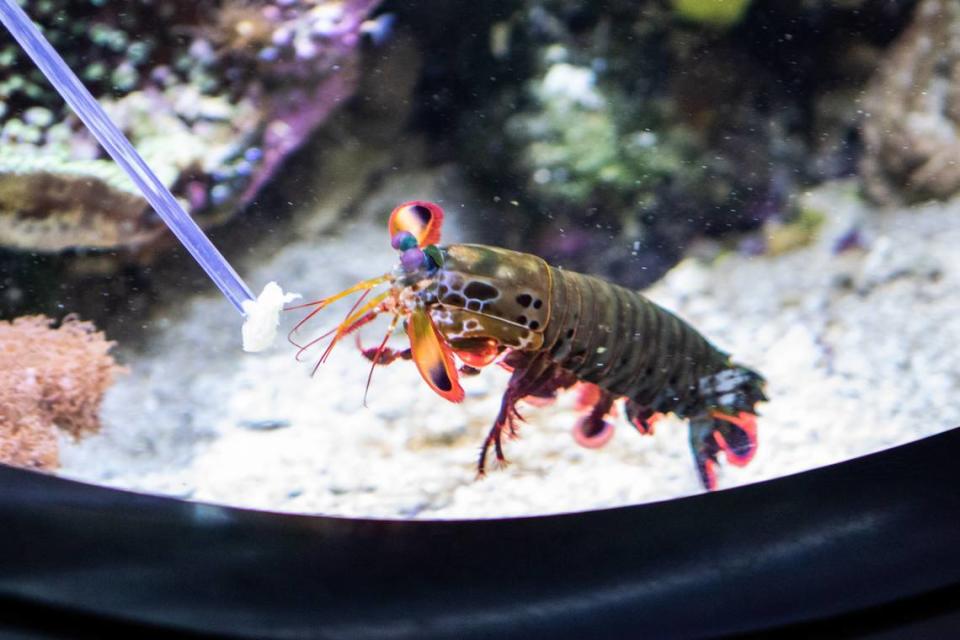This SC critter has the world’s fastest punch & can strike faster than a bullet. Here’s how
Among the many shrimp species that surround South Carolina’s coast, the mantis shrimp stands out as the most notable of them all.
Although not even a true shrimp species, mantis shrimp, or stomatopods, are distant relatives of crabs, lobsters and shrimp. They get their name because this carnivorous marine crustacean resembles a mix between a praying mantis and a shrimp. Occasionally, they can even be described as appearing similar to a lobster.
Often seen in local waters along the state’s coast and along the Southeastern U.S., the mantis shrimp can be found in shallow tropical or subtropical waters.
“The mantis shrimp (not a true shrimp) is a flattened, inshore crustacean sometimes incorrectly called ‘rock shrimp,’” says SCDNR about the species.
“Mantis shrimp can be eaten, but have little meat of poor quality,” SCDNR continues.
With over 450 species of mantis shrimp worldwide, they are a common sight seen in a variety of different colors and can grow anywhere from 12 to 15 inches in length. The most frequently spotted and most noted species is the peacock mantis shrimp, also called the harlequin or painted mantis shrimp, and the zebra mantis shrimp.

They can be found along coastal shores, usually living in an abandoned burrow, sometimes U-shaped, and can move in and out to capture nearby prey when spotted. The fast and vicious stomatopods can also live in coral reefs or rock crevices.
These marine critters can be active during the day or live nocturnally depending on the specific mantis shrimp species.
Mantis shrimp spend the majority of their lives living in burrows, reefs or crevices and generally only leave to mate or hunt for nearby food sources. Mantis shrimp act as an ecological importance to their coral reefs. This is because they are incredibly sensitive to surrounding environmental pollutants and their behavior can indicate when conditions may be poor.
“They have a unique set of “thumb splitters” or small appendages that they use to break or crack open shells of other crustaceans to retrieve food and nutrients. They are the fastest known organism due to their quick jabbing appendages that can reach up to 170 mph,” according to Lamar University.
Mantis shrimp pack the strongest punch of any creature in the animal kingdom. Their club-like appendages accelerate faster than a bullet out of a gun, detailed Leah Burrows in a research article through Harvard University’s School of Engineering and Applied Sciences.
These appendages can be used in two separate ways, generally seen through hunting and attacking from the species.
“There are two main types of hunting for mantis shrimp: spearing and smashing. Smashing mantis shrimp have calcified forelimbs that they use to administer a powerful strike to both predators and prey. Spearing mantis shrimp have sharp forelimbs they use to pierce predators and prey,” according to the Great Barrier Reef Foundation.
Fishermen and marine specialists alike have stated that the mantis shrimp’s claw is dangerous, and caution is necessary to avoid getting hurt.
“The title of fastest punch in the animal kingdom firmly belongs to the peacock mantis shrimp, whose club-like appendages reach the speed of a .22-caliber slug, shatter clamshells with ease and can slice human fingers to the bone,” wrote The Washington Post.
Mantis shrimp can act aggressively, and their jabs and blows have been described as “devastating” to their prey or to many who choose to spar with one.
Their claws are strong enough to break glass or even wound a human; thus, giving them the nickname “thumb splitters.”
Often described as having the fastest limb movements in the animal kingdom, falling just short of the Dracula Ant, the mantis shrimp earns extra points considering the substantial drag imposed by water during such a strike. Although water is much denser than air, the mantis shrimp is able to execute its strike in under three-thousandths of a second, according to National Geographic.
The reason the mantis shrimp is capable of such speeds is due to its unique anatomy.
If it solely flicked out its arm, similar to how a human would, it could never achieve such speeds.
Mantis shrimps use a simple energy storage system where, once the arm is cocked, a ratchet locks it firmly in place. Large muscles in the upper arm then contract and build up energy. When the latch is released, all this energy is released at once and the lower arm is launched forwards, continued National Geographic.

